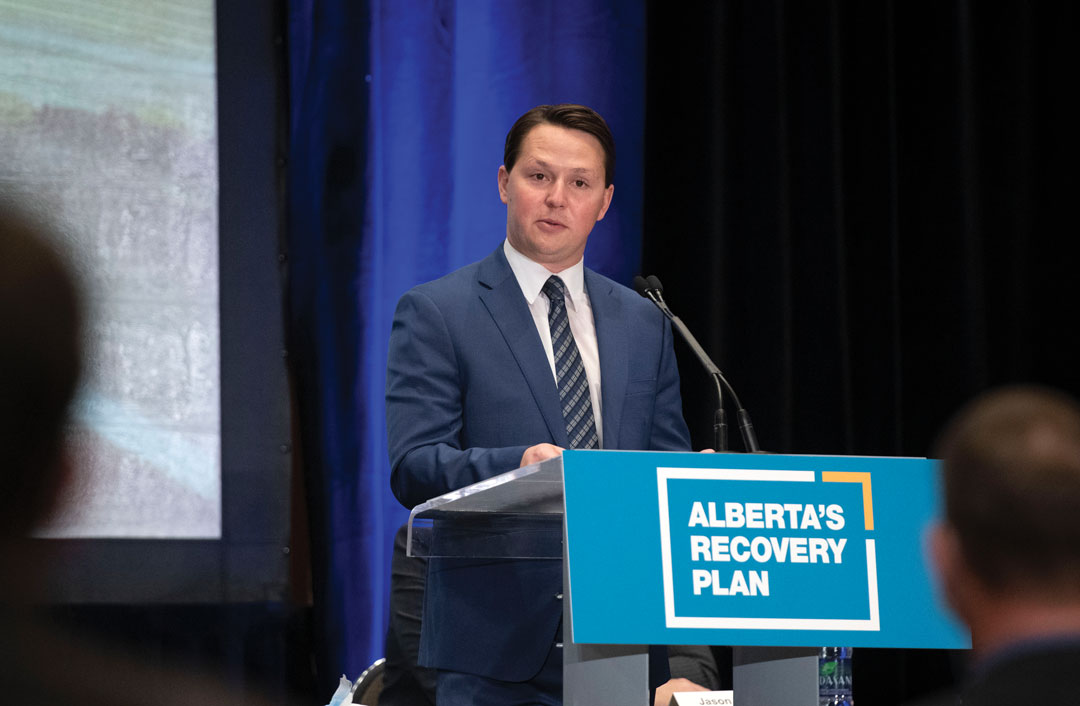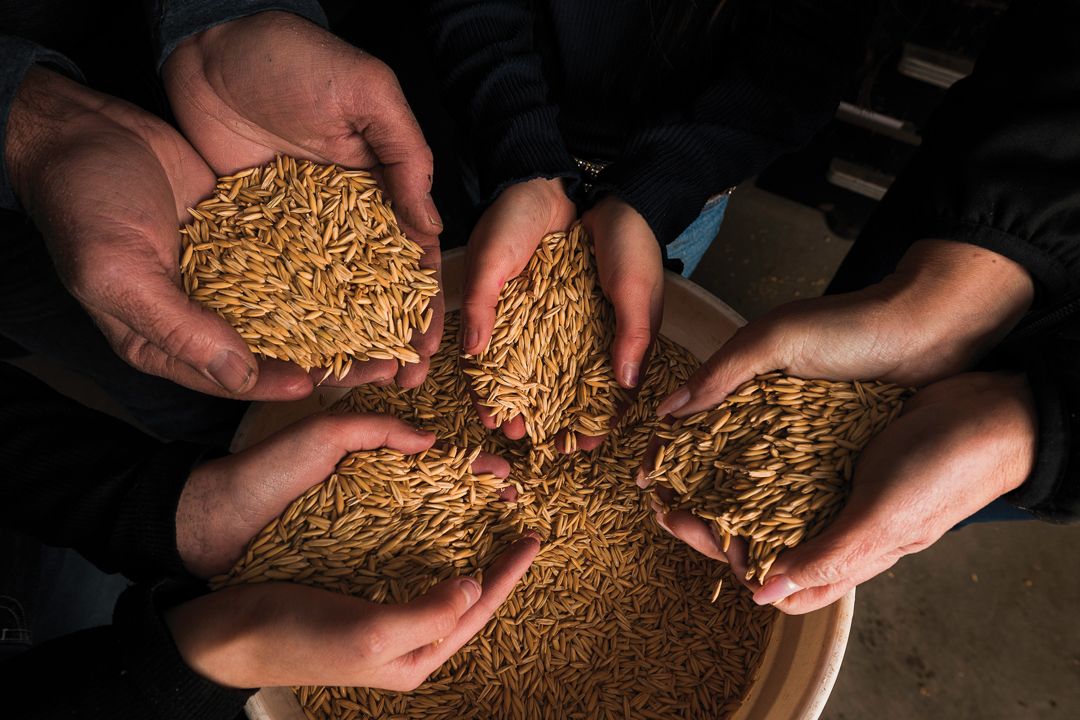ALBERTA RECOVERY PLAN GOES INTO ACTION
BY JENNIFER BARBER • PHOTO COURTESY OF ALBERTA AGRICULTURE AND FORESTRY: DEVIN DREESHEN ANNOUNCES IRRIGATION INITIATIVE IN OCTOBER 2020
With the initial projects recently announced, the first agriculture industry-related elements of the Alberta Recovery Plan are now up and running. From investment in irrigation infrastructure, to the opening of new international export offices, to new post-secondary research funding, the initiatives are intended to position agriculture and forestry as a part of the solution to Alberta’s economic woes.
“We’ve been rolling out several projects that invest in the future of agriculture in this province,” said Alberta Minister of Agriculture and Forestry (AF) Devin Dreeshen. “We’ve announced more than $1.4 billion in investment and have been working with 30 different companies to try and attract them to set up shop in Alberta. We want to increase our processing and crushing capabilities, with a goal of 2,000 value-added jobs.”
Premier Jason Kenney first announced the details of the Alberta Recovery Plan in April, and asked the Business Council of Alberta to establish sector-specific groups that would report back to the Premier’s Economic Recovery Council. The Agriculture and Forestry Economic Recovery Table was one piece of a multi- sector response to help the province recover from the effects of the COVID-19 shutdown. The Table is composed of representatives from a variety of commodity groups as well as crop protection, farm machinery, marketing and ag retail organizations. The working group produced a strategic action plan that has identified areas of potential revenue growth and job creation for both the agriculture and forestry sectors.
“We initially met weekly during the spring and our meetings were focused at that point on a lot of unknowns,” said Tom Steve. General manager of the Alberta Wheat and Barley Commissions, he also sits on the Economic Recovery Table. “Early on we didn’t know what the impact of COVID-19 was going to be on the ag and forestry sectors. We didn’t know if agriculture would be considered essential or if grain would be able to move.”
As it became clear agriculture and forestry were considered essential on a global scale, and would be able to function within the limits of public health constraints, the group’s efforts quickly shifted to the development of concrete ways the industry can play a role in broader provincial recovery efforts.
“We’ve seen the resiliency of the agriculture industry and its ability to bounce back quickly,” said Steve. “This year Alberta farmers will have brought in one of the largest harvests ever against the backdrop of COVID-19. We needed a break in weather after several bad years, and this year we got it. Because the railways are not moving as much other cargo, grain movement has been efficient. We’ve all realized that agriculture can be part of the solution to the economic struggles this province is facing.”
The agriculture and agri-food sectors showed a strong overall performance in 2020 according to figures released by AF. It is estimated livestock market sales will reach a record high of $6.9 billion. The food processing sector also hit record highs with products totalling $14.8 billion.
The draft strategic action plan has been presented to the province’s Economic Recovery Council and the Economic Recovery Table will meet with Dreeshen to discuss its ideas. Steve said the details of the plan are fluid, based on the changing situation with the pandemic, and the ability of the industry and markets to respond to it. However, it initially established 11 priority areas.
“The short-term focus is on job creation to jumpstart the economy, but there is also an ongoing interest in value-added opportunities on our raw products,” he said. “Another area of critical importance is high-speed connectivity access in rural areas. In order to embrace newer technologies, that high-tech connectivity will be critical.”
Steve added recommendations include the creation of apprenticeship training programs and a focus on post-secondary research institutions. The plan also addresses sustainability and climate change with the suggestion the agriculture industry capitalize on fuel-efficient equipment.
Together with funding from the Canada Infrastructure Bank and eight irrigation districts, the province also announced an $815-million expansion of irrigation services, with the goal of bringing 200,000 additional acres of irrigated land into production.
This will include four new reservoirs and the conversion of open-air water storage into canals and pipelines. The project will generate 6,800 direct and indirect permanent jobs as well as 1,280 construction jobs. By securing irrigation access in southern Alberta the province hopes to encourage more value-added production in the area.
The province will also invest in applied crop variety development and agronomic research. SAIT, Red Deer College and Olds College will receive $2.1 million in grants through the research capacity program to boost learning technology, including in the area of smart farming.
“Forestry has also had a banner year,” said Dreeshen. “The province collected more than $350 million in timber dues. That is a third of what Alberta made from oil and gas and it is not something that traditionally gets a lot of notice. Forestry employs more than 40,000 Albertans, and agriculture more than 70,000 people. These industries are important to a lot of Albertans.”
The Table also discussed trade and exports. Invest Alberta is a Crown corporation that works to attract global investment to the province, including to its agricultural sector. The intent is to capitalize on fast-growing global demand for high-quality, safe food. In order to locate and create export opportunities, Alberta will send representatives from the agriculture industry to four major Invest Alberta global trade offices and add employees to existing offices.
“Attracting investment into Alberta’s agribusiness sector is one of Invest Alberta’s top priorities,” said David Knight Legg, CEO of the Invest Alberta Corporation. “Strengthening our international network with these dedicated trade and investment experts will not only broaden Alberta’s international reputation as an agriculture and agri-food powerhouse, it will help create opportunities for our farmers and jobs in communities here at home.”
The province has set aggressive growth targets for exports by 2023, with an ambitious goal of 8.5 per cent per year growth for value-added agricultural exports and 7.5 per cent per year growth for primary ag exports for an overall 43 per cent increase over 2018 exports to $16.6 billion.
“Reducing red tape is important for this government and we know that global trade is important for Alberta’s agriculture industry and these agriculture specific trade offices will double our international presence,” said Dreeshen. “The first office will open in Singapore and will be a key strategy to expanding our network into Southeast Asia and provide Alberta producers with better market access.”
The Table will continue to meet to provide input when requested by the government. Steve said the group has an open line of communication with the government and as the pandemic evolves it will continue to put ideas forward.
“Agriculture can be part of the economic solution in this province and this will be demonstrated by how quickly we recover,” he said. “It’s great for the agriculture sector to see our ideas come to fruition. But this pandemic is ongoing and so are the challenges that come with it. Our work isn’t done by any stretch.”







Comments